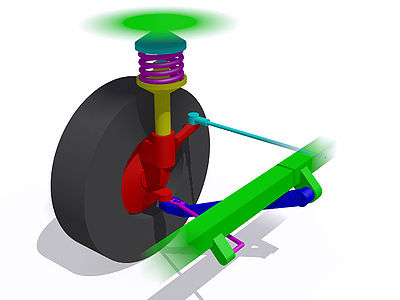- MacPherson strut
-
 A simple MacPherson strut suspension on the left front wheel of a rear-wheel drive vehicle. Front of the vehicle top right in image.
A simple MacPherson strut suspension on the left front wheel of a rear-wheel drive vehicle. Front of the vehicle top right in image.
Red section: Steering knuckle or hub carrier
Blue section: Lower control arm or track control arm
Light blue section: Steering gear tie rod
Lower purple section: Radius rod
Upper purple Section: Coil spring
Yellow section: Tubular housing containing shock absorber or damperThe MacPherson strut is a type of car suspension system which uses the axis of a telescopic damper as the upper steering pivot. It is widely used in modern vehicles and named after Earle S. MacPherson, who developed the design.
Contents
History
Earle S. MacPherson developed the design of the strut in 1949 partially based on designs created by Guido Fornaca of FIAT in the mid-1920s.[1] It is possible the MacPherson was inspired by the suspension on the French Cottin-Desgouttes that used the same design, but with leaf springs. Cottin-Desgouttes front suspension was in turn inspired by J. Walter Christie's 1904 design and he was inspired by plants.[2]
The first car to feature MacPherson struts was the 1949 Ford Vedette,[3] and it was also adopted in the 1951 Ford Consul and later Zephyr. MacPherson originally created the design for use at all four wheels (Mitsubishi Starion, for example), but production applications used it only for the front suspension, where it provides a steering pivot (kingpin) as well as a suspension mounting for the wheel.
Design
MacPherson struts consist of a wishbone or a substantial compression link stabilized by a secondary link which provides a bottom mounting point for the hub or axle of the wheel. This lower arm system provides both lateral and longitudinal location of the wheel. The upper part of the hub is rigidly fixed to the inner part of the strut proper, the outer part of which extends upwards directly to a mounting in the body shell of the vehicle.
To be really successful, the MacPherson strut required the introduction of unibody (or monocoque) construction, because it needs a substantial vertical space and a strong top mount, which unibodies can provide, while benefiting them by distributing stresses.[4] The strut will usually carry both the coil spring on which the body is suspended and the shock absorber, which is usually in the form of a cartridge mounted within the strut (see coilover). The strut also usually has a steering arm built into the lower inner portion. The whole assembly is very simple and can be preassembled into a unit; also by eliminating the upper control arm, it allows for more width in the engine bay, which is useful for smaller cars, particularly with transverse-mounted engines such as most front wheel drive vehicles have. It can be further simplified, if needed, by substituting an anti-roll bar (torsion bar) for the radius arm.[4] For those reasons, it has become almost ubiquitous with low cost manufacturers. Furthermore, it offers an easy method to set suspension geometry.[5]
Advantages and Disadvantages
Although it is a popular choice due to its simplicity and low manufacturing cost, the design has a few disadvantages with regards to the quality of ride provided and how it affects the handling of the car. Geometric analysis shows it cannot allow vertical movement of the wheel without some degree of either camber angle change, sideways movement, or both. It is not generally considered to give as good handling as a double wishbone suspension, because it allows the engineers less freedom to choose camber change and roll center. Another drawback is that it tends to transmit noise and vibration from the road directly into the body shell, giving higher noise levels and a "harsh" feeling to the ride compared with double wishbones, requiring manufacturers to add extra noise reduction or cancellation and isolation mechanisms. Also, because of its greater size and robustness and greater degree of attachment to the vehicle structure, when the internal seals of the shock absorber portion wear out replacement is expensive compared to replacing a simple shock absorber.[citation needed]
Despite these drawbacks, the MacPherson strut setup is still used on high performance cars such as the Porsche 911, several Mercedes-Benz models and nearly all current BMWs (including the new Mini) excluding the 2007 X5,[6] 2009 7-series, 2011 5-series and 5-series GT,.
The Porsche 911 up until the 1989 model year (964) use Macpherson strut designs that do not have coil springs, using a torsion bar suspension instead.
See also
References
- ^ Setright, L.J.K., "MacPherson Strut: Legs to Support the Car", in Northey, Tom, ed. World of Automobiles (London: Orbis, 1974), Volume 11, p.1235.
- ^ Aftonbladet: Fjädrar, vilken framvagn!
- ^ "4Car 100 Greatest Innovations". Archived from the original on 2006-11-04. http://web.archive.org/web/20061104223423/http://www.channel4.com/4car/100-greatest/innovations/suspension.html. Retrieved 2006-08-16.
- ^ a b Setright, p.1235.
- ^ Setright, p.1236.
- ^ "Autocar review of 2007 X5". http://www.autocar.co.uk/CarReviews/FirstDrives/BMW-X5-4.8i-SE/222801/. Retrieved 2007-04-12.
External links
Categories:- Automotive suspension technologies
Wikimedia Foundation. 2010.
